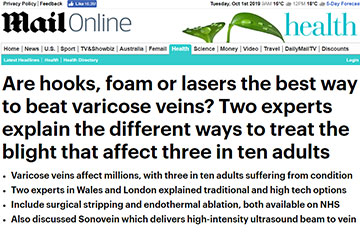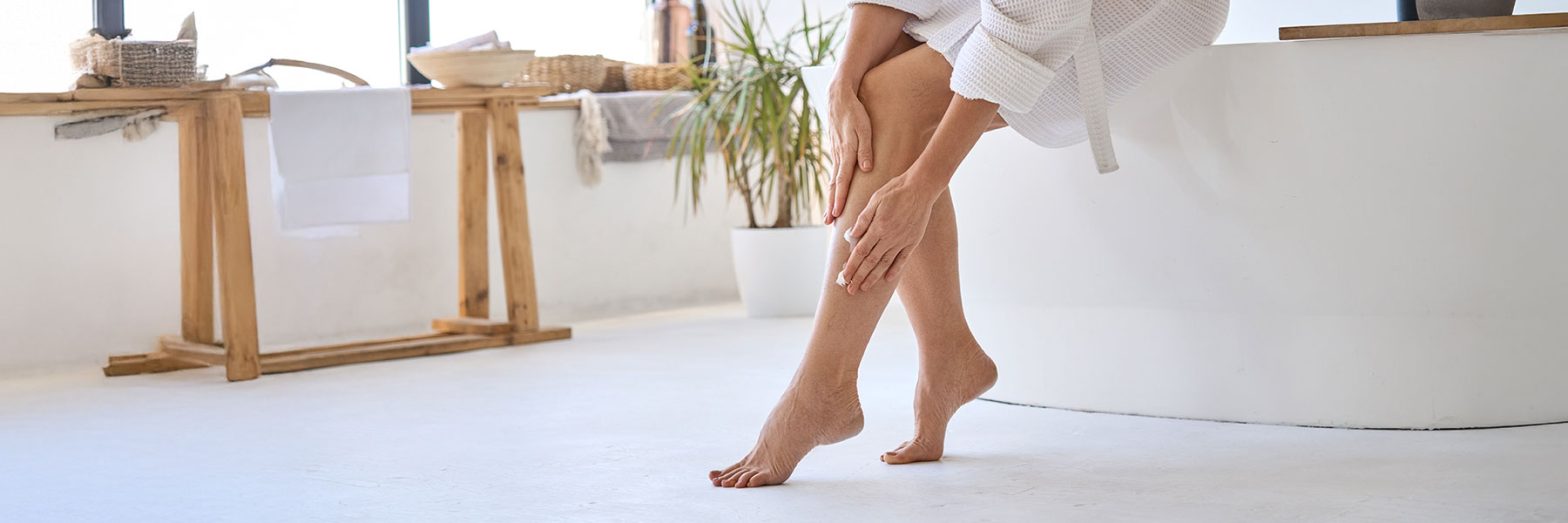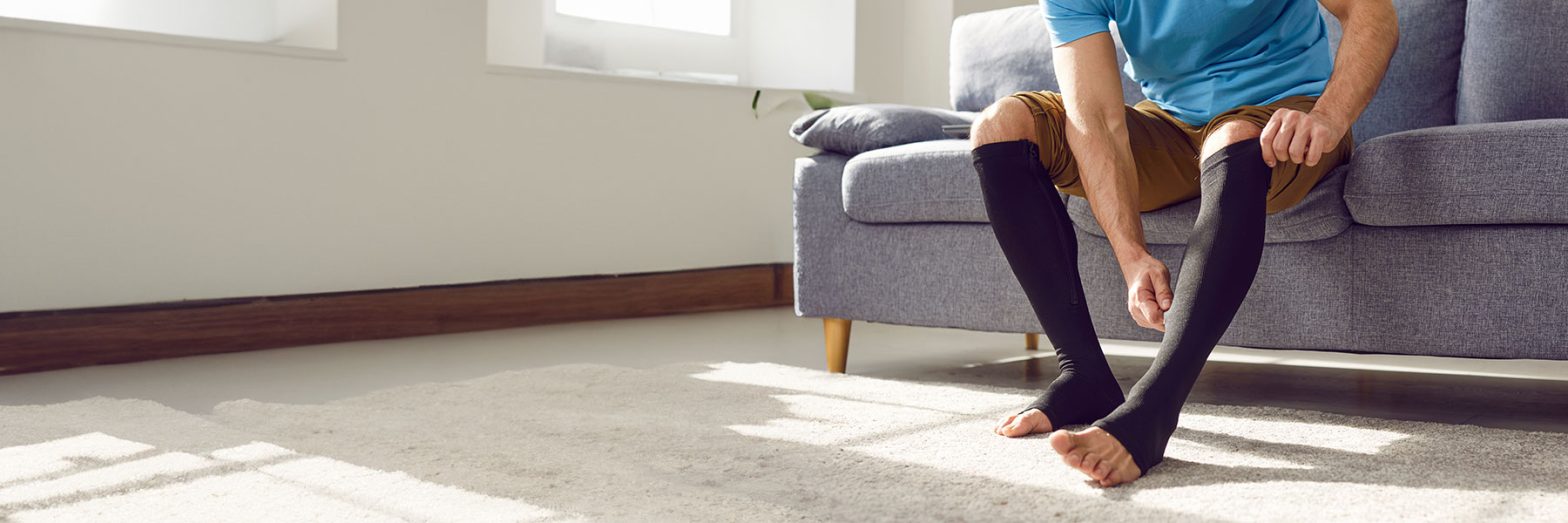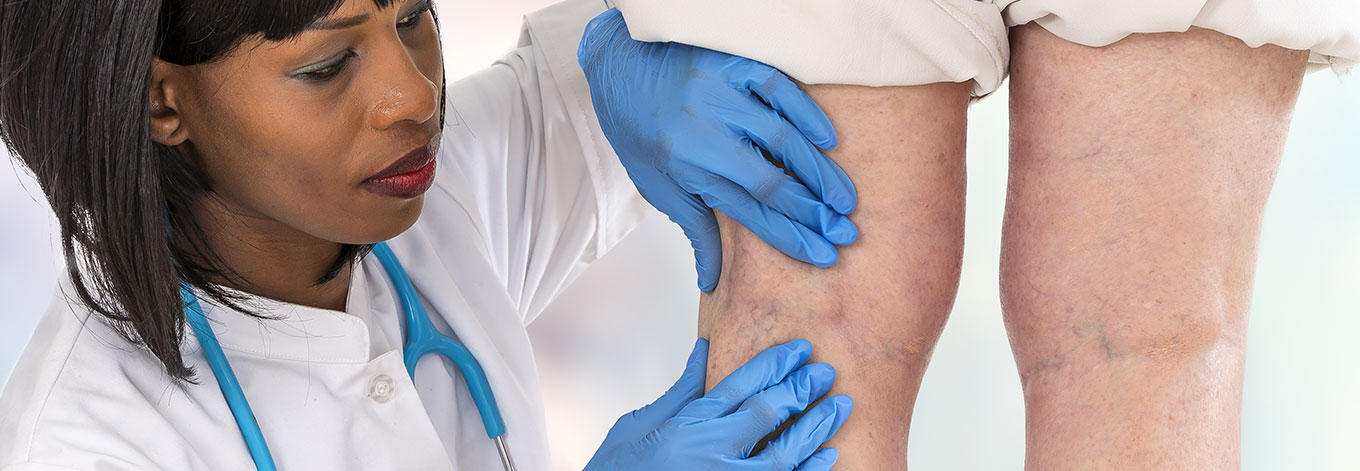
Are hooks, foam or lasers the best way to beat varicose veins?
VEINS
Daily Mail
Varicose veins are a blight that affects millions of us, with three in ten adults suffering from the condition.
[…]
When it comes to treatment, the NHS has a strict grading system: only people whose varicose veins are at the higher end of the one-to-six scale (one being mild, while six is advanced) are eligible. Many turn to the private sector for treatment.
Here, Costas Kyriakides, a consultant vascular surgeon at Barts Health NHS Trust and The Private Clinic in London, and David Lewis, a consultant vascular surgeon at The Royal Gwent Hospital in Newport and Spire Cardiff Hospital, explain the different options — from traditional to high-tech.
SURGICAL STRIPPING
HOW IT WORKS: Ligation and stripping has been the traditional way to treat varicose veins for decades.
Under general anaesthetic, two small incisions are made and a flexible wire is inserted into the vein and then pulled out, removing the vein in one section. A compression bandage is worn for up to a week to aid healing and patients are advised to stay off work for two weeks.
EXPERT VERDICT: Mr Kyriakides says: ‘About a fifth of surgeons still use this technique, which is suitable for most fit patients. However, there’s a 10 per cent risk of infection and bleeding, and up to a 5 per cent risk of damage to surrounding deeper veins, arteries and nerves. It’s also associated with a higher rate of recurrence due to new vein formation or incomplete stripping of the vein.
‘Recovery time is longer than other options and it leaves a scar of about 2 in.’
AVAILABILITY: NHS and privately.
COST: From £3,000.
ENDOTHERMAL ABLATION OR ENDOVENOUS LASER
HOW IT WORKS: These minimally-invasive, 20-minute techniques use heat to destroy the varicose vein with either high-frequency radiowaves or a laser.
In each case, the patient has a local anaesthetic before a small incision is made above or below the knee. A catheter — a thin tube — is then inserted into the problematic vein, and via this, radiowaves or a laser are used to heat the walls of the vein, causing it to collapse and closing off its blood supply. (The vein eventually withers away and is absorbed by the body.) Blood immediately starts to flow along a different vein.
EXPERT VERDICT: Mr Kyriakides says: ‘In 2013, The National Institute for Health and Care Excellence (Nice) recommended endothermal ablation as a first-line treatment for varicose veins, and it’s now considered the gold standard treatment, followed by foam sclerotherapy.
‘Both options were introduced about 20 years ago and are around 98 per cent effective. They are best suited to patients with straight veins (which account for 95 per cent of varicose veins).
‘As it’s a minimally-invasive treatment, the risk of bleeding and infection is rare. The 1-2mm incision does not need stitching; adhesive strips can be used, leaving only a tiny scar. Patients can be at work the next day, although they might feel stiffness for three days.’
AVAILABILITY: NHS and privately.
COST: From £2,000.
ULTRASOUND-GUIDED FOAM SCLEROTHERAPY
HOW IT WORKS: This chemically destroys the lining of the vein, causing it to collapse. Guided by ultrasound, it involves a fine foam being injected directly into the vein, which causes it to scar on the inside and the walls of the vein to stick together, closing it off.
The procedure takes 30 to 60 minutes, and afterwards bandages and compression stockings are worn to reduce lumpiness developing where the vein was sealed off. The patient can be back to work the same day.
In a Nice study, this was successful in 84 out of 100 cases, which is a lower success rate than other minimally-invasive procedures — but it can be repeated.
EXPERT VERDICT: Mr …. says: ‘A form of this treatment has been around for decades. Now, foam rather than liquid is used, leading to more predictable results and fewer complications; the vein will disappear in six to 12 weeks.
‘It’s used to “tidy up” veins that aren’t dealt with by endothermal ablation. However, if too much foam is used, it can increase the risk of complications such as headaches, visual disturbance and stroke, although I’ve never had any issues with it.
‘There’s a 5 to 10 per cent risk of “staining”, where the destroyed vein leaves a mark on the skin. This usually fades after three months but can take up to a year.
‘Patients can return to normal activities within 24 hours.’
AVAILABILITY: NHS and privately.
COST: Between £1,000 to £3,000.
PHLEBECTOMY
HOW IT WORKS: Under a general or local anaesthetic, a surgical instrument called a phlebectomy hook is used to pull out the vein in segments. The incisions are closed with glue or paper ‘stitches’.
EXPERT VERDICT: Mr Lewis says: ‘While we may treat the main trunks of varicose veins with endothermal ablation, multiple phlebectomies are favoured by many surgeons for smaller, side branches because the procedure is arguably less technically challenging than some other techniques.
‘A phlebectomy can be quick depending on how many veins are removed, but can cause more discomfort afterwards due to cuts and bruising. Patients need to wear compression stockings for about a week and can return to work in under a week.
‘As with all treatments, varicose veins can return, although phlebectomies have a success rate of 84 per cent. This is better than other techniques for “tidying up” if more tortuous veins remain after ablation has been used to take away straight ones.’
AVAILABILITY: NHS and privately.
COST: From £,1,000.
[…]
VENASEAL
HOW IT WORKS: This 30-minute procedure uses medical-grade adhesive to stick the vein together, via a hollow tube called an introducer. The maker says it is painless, with a recovery time of 72 hours, without the danger of thermal injury.
EXPERT VERDICT: Mr Kyriakides says: ‘This treatment has been in mainstream use for around five years and is like putting superglue in the veins to seal them off. The dead vein and hardened glue is then broken down and absorbed into the body.
‘One of the main advantages is that you only need a small amount of local anaesthetic where the catheter goes in and not along the length of the vein.
‘Published clinical studies showed it had an initial success rate of between 94 to 98 per cent six months after treatment.
‘It is very effective — though maybe not so for large diameter (more than 9mm) varicose veins as they may not seal. Its cost can be prohibitive. But as there is no need for a local anaesthetic in the thigh, it’s more pleasant for some patients compared, for example, to endothermal ablation.’
AVAILABILITY: Privately only.
COST: From £3,500.
For more information or to book a consultation with Mr Constantinos Kyriakides, Consultant Vascular Surgeon at The Private Clinic of Harley Street use our varicose vein online contact form.
[…]








